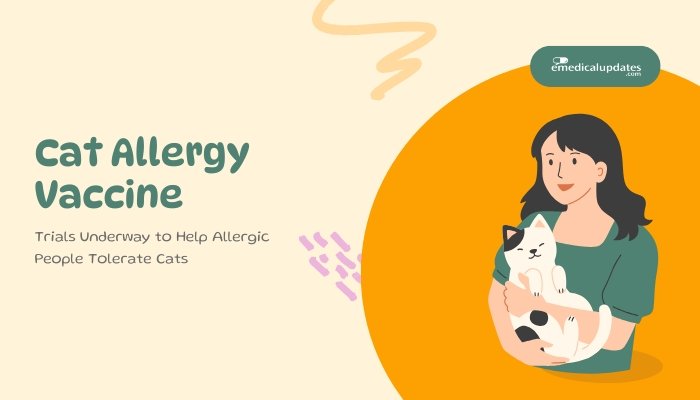Introduction
Cat allergies can be distressing—sneezing, itchy eyes, and difficulty breathing often force cat lovers to live pet-free. Current options include antihistamines, nasal sprays, or allergy shots, but these come with limitations.
Now, researchers are exploring a cat allergy vaccine designed to help allergic individuals develop lasting tolerance to cat allergens. Early trials show promise, potentially sparing cat owners from constant medication or the heartbreak of giving up a beloved pet. Below, we dive into how this vaccine works, clinical progress, and what it might mean for cat enthusiasts worldwide.
Understanding Cat Allergies
Common Allergens
- Fel d 1: The primary protein culprit in cat saliva and dander. When cats groom themselves, Fel d 1 spreads onto fur and then into the environment.
- Airborne Exposure: Tiny allergen particles can linger in the air, triggering immune reactions for sensitized individuals.
Effects on Sufferers
Symptoms often involve:
- Respiratory: Sneezing, runny nose, coughing, wheezing (in asthmatics).
- Eye Irritation: Redness, itching, tearing.
- Skin Reactions: Hives or eczema flare-ups from direct contact.
Current Allergy Management
Medication and Environmental Controls
- Antihistamines, Nasal Steroids: Relieve symptoms but require ongoing use.
- Immunotherapy (Allergy Shots): Over time, repeated injections reduce immune sensitivity, though the regimen can last years and efficacy varies.
Lifestyle Adjustments
- Limiting Exposure: Keeping cats out of bedrooms, using HEPA filters, frequent vacuuming.
- Bathing Cats: Minimally helpful, as new allergens accumulate quickly.
- Hypoallergenic Breeds?: No cat is truly allergen-free, though some produce less Fel d 1.
The New Cat Allergy Vaccine
Targeting Fel d 1
This experimental vaccine aims to desensitize the human immune system to Fel d 1. By exposing the body to a modified version or fragments of the protein, the therapy tries to induce a tolerant immune response—so future contact with real cat allergens won’t provoke the usual allergic cascade.
Mechanism of Action
- Peptide Fragments: The vaccine might contain synthetic peptides representing parts of Fel d 1.
- Immune Tolerance: Administered in a controlled dosage schedule, it conditions the immune system to recognize these peptides as harmless, reducing or preventing the overreaction.
Administration Schedules
Some trials explore a short series of injections or a few sessions of intralymphatic injections, potentially faster than multi-year immunotherapy. However, optimal dosing frequency remains under investigation.
Clinical Trial Progress
Early Phase Studies
Small pilot studies suggest:
- Less Symptomatic Reaction: Participants exposed to cat dander exhibit milder allergic symptoms post-vaccine.
- Good Tolerability: Few serious adverse events, mostly injection-site discomfort or mild, transient allergic responses.
- Biomarker Shifts: Blood tests show decreased IgE reactivity to Fel d 1.
Larger Trials Underway
To verify real-world efficacy, researchers are enrolling more participants across diverse age groups and intensities of allergy:
- Comparing to Placebo: Double-blind designs ensure robust data on safety and effect size.
- Monitoring Lasting Benefits: Trials track participants for months to years, ensuring the tolerance persists.
Potential Benefits
- Fewer Medications: If successful, many could reduce daily antihistamines, inhalers, or nasal sprays.
- Lifestyle Freedom: Living with or visiting cat-owning friends becomes feasible without fear of severe reactions.
- Broader Access: Could become a shorter alternative to standard immunotherapy, which often requires weekly or monthly shots over years.
Challenges and Considerations
Cost and Insurance Coverage
As a novel therapy, the cat allergy vaccine might initially be expensive, and coverage might be uncertain. Health insurers weigh evidence of efficacy and cost-effectiveness before routine reimbursement.
Long-Term Safety
Though trials so far show minimal side effects, large-scale and extended post-marketing data would confirm no unexpected complications, like new allergies or autoimmune triggers.
Variability of Allergic Profiles
Not all cat allergies are due to Fel d 1 alone—some involve additional cat proteins. The vaccine’s success might vary among different allergen sensitivities, requiring further customization or multi-target expansions.
Future Outlook
Personalized Allergy Shots
If research fosters a deep understanding of each patient’s allergen triggers, upcoming versions of the vaccine could tailor the immunizing peptides to each individual’s unique IgE profile, boosting success rates.
Extending to Other Pet Allergies
The approach might easily be adapted for dog or horse allergies, using a similar design. Pet lovers across species might benefit from targeted immunotherapy, ushering in a new wave of allergy solutions.
Widespread Use
Following successful large trials and regulatory approvals, the cat allergy vaccine could enter specialist or general allergist practice, making mainstream adoption feasible—particularly in communities with high pet ownership.
Frequently Asked Questions
- Could this vaccine cure my cat allergy?
- It aims to reduce or eliminate allergic reactions, functioning like a specialized immunotherapy. “Cure” is a strong term, but significant symptom relief is the goal.
- When might it be available?
- It depends on trial results and approval processes. A few years away at least, assuming successful Phase III data.
- Does it involve multiple shots or a single injection?
- Current regimens may require a short series of injections over months, but specifics remain in flux as trials refine protocols.
- Is it safe for children?
- Trials typically begin with adults. Pediatric use requires separate trials or expansions of existing studies.
- Will it help for other animal allergies?
- This approach is Fel d 1-specific. Dog or other pet allergens would need separate targeted peptides or therapies.
Conclusion
A cat allergy vaccine stands on the horizon, with early clinical trials suggesting it might slash allergic symptoms by building tolerance to the key cat allergen, Fel d 1. If successful, this therapy could relieve millions of cat-allergic individuals from reliance on daily meds, extensive cleaning regimens, or total avoidance of cats. As research continues, experts remain cautiously optimistic that in a few years, individuals with cat allergies may be able to coexist with feline companions more comfortably and spontaneously. For now, watchers of this emerging technology can remain hopeful that new solutions for allergic care are poised to transform how we manage persistent allergies across the board.
References
-
Senti G, et al. (2020). “Novel immunotherapeutic peptides for cat allergies.” J Allergy Clin Immunol.
-
Ollert M, et al. (2021). “Fel d 1 vaccine progress in allergic disease.” Allergy.
-
European Academy of Allergy and Clinical Immunology (EAACI). (2022). “Position paper on emerging cat allergy therapeutics.”
-
AAAAI (2023). “Ongoing clinical trials for cat allergy vaccine.”







